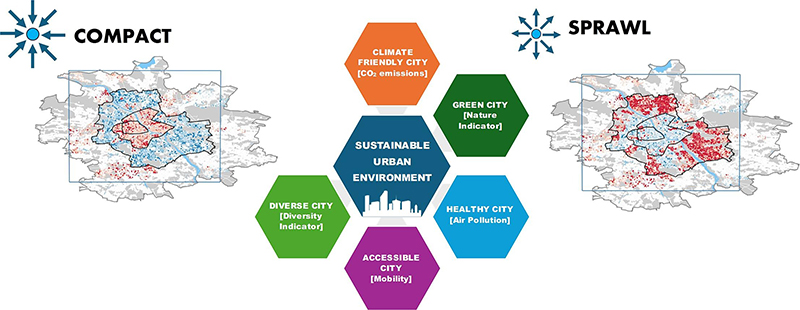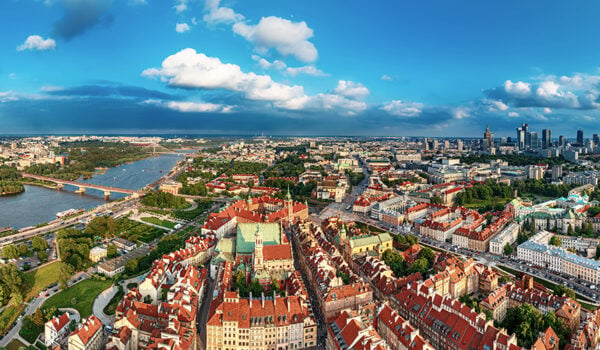Two decades of growth has left the Polish capital Warsaw sprawling. A trend of wide-spread suburbs, lacking key amenities and access to public transportation, has made the city an interesting modelling example for scientists working with urban environment. How do you best design a healthier place to live?
“When you live somewhere, it’s about more than just a roof over your head. You need access to food stores, schools, pharmacies, kindergartens, meeting places, public transport – you name it. If these aren’t available in your neighborhood, you drive to wherever you can find them,” says senior scientist Dr Susana Lopez-Aparicio at NILU.
She and her colleagues at NILU, together with a team of Polish researchers, investigated how urban expansion can be done in an environmentally sustainable way. They were especially interested in transport emissions and air quality. Warsaw was used as a case study, but their findings are transferable to other cities as well.
Suburban sprawl encourages car use
“Over the last twenty plus years, Warsaw has seen unprecedented growth – with housing prices rising accordingly. Until recently, the expansion of Warsaw’s metropolitan area has, for a large part, happened with no overall plan. This has led to a very distinguishable pattern of so-called suburban sprawl. Natural land has been replaced by detached houses, with little room left for amenities and services. We dubbed this a ‘suburban monoculture’ of detached houses,” says Dr Henrik Grythe.
Such sprawling cities encourage more everyday use of cars, longer commutes, and traffic congestion. This leads to increasing emissions of both carbon dioxide (CO2) and nitrogen oxides (NOx).
So, how do you avoid that?
The way a city is designed influences how people travel to their daily destinations. Can you get to work easily and effectively by public transport? Is your doctor’s office within walking distance? Can your kids safely bicycle to school? All these factors shape our mobility patterns and decide what kind of transport we use.
Where do people need to go?
With Warsaw as their backdrop, the scientists modelled and evaluated two potential ‘city design’ scenarios: Continuous sprawling and alternative compact development. The two demonstrated quite contrasting outcomes.

“In the continuous sprawling scenario, we moved people out from the city center and to the suburbs. This resulted in a 47% increase in CO2 transport emission for the moved population, as the additional suburbians also need to use cars for their commute and errands. Not only did the model show that they would use their car for more trips: Each trip also increased in length. Perhaps more surprisingly, the traffic in the downtown area didn’t go down much at all. While we couldn’t model everything with enough specific granularity to detail out all effects, we think the fact that there are no proper ring roads is important. Thus, most people living in the suburbs still had to drive through the city center to get to other parts of town,” says Grythe.
In the other scenario, they moved people in the opposite direction, towards downtown. This compact development scenario reduced overall traffic CO2 and NOx emissions.
Reducing the polluting emissions is usually positive. The more air pollutants there are in the air we breathe, the more we are exposed to it. But in this case, compacting the population had a negative effect on human exposure.
“If we increase the population density in the city center while the pollution stays the same, we just end up with more people being exposed to harmful air quality levels. In our models of compact Warsaw, this is exactly what happened. While there was a significant drop in emissions, the concentration of pollutants was still high in the areas where now even more people live. Thus, the exposure to air pollution went up in the compacted city,” says Lopez-Aparicio.
The scientists also needed to consider the fact that if possible, people living in the suburbs prefer to go into the city center by car. When you reduce overall traffic by re-allocating parts of the suburban population to downtown, the freed-up space on the road is taken up by an increase in downtown traffic from the suburbs. While the city dwellers suffer most of the consequences of air pollution, the people from the suburbs are responsible for the underlying emissions, even in the city center.
Compact living “wins”
The scientists modelled additional traffic measures to see what the ideal city development would be.
“In reality, it is of course much harder to force people to move in or out of the city than in our model. In addition to the different city developments, we tried several measures to both reduce emissions and improve the air pollution levels. We improved public transport, limited road capacity to force people to not use cars, we moved workplace centers around – we tried everything we could think of,” says Grythe.
The only thing that helped? Improving public transport. Aside from that, anything related to reducing the road network capacity only increased congestion and did nothing to reduce emissions.
“Following up suburban expansion with moving workplaces to the suburbs only made matters worse in our model of the suburban sprawl scenario. All our modelled mitigation measures ended up being more effective in the compacted city. So at least within the limits of our scope, any mitigating measure applied to reduce transport emissions will be more efficient in a compact city. So, compaction is where you should start – despite the increased exposure to air pollutants,” says Grythe.
Design for easy access to “everything”
Road transport and residential heating are the main causes of air pollution in European cities. Thus, understanding how urbanization, emissions and air quality associated with road traffic affect each other is essential to design healthier cities.
When asked how they would design a city for optimal air quality, Susana Lopez-Aparicio would go for the so-called “hub” or centralized, compact city design.
“I would prioritize easy, car-free access to everything you need in your daily life. If all main services and efficient public transport are available locally, it aids in reducing local air pollution,” she says.





